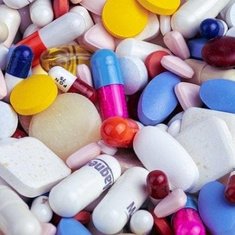|
what is narcosis?
|
|
the bigger picture, downstream cellular effects that toxins can have
|
|
what is necrosis?
|
what do dying cells do during necrosis?
|
what affect will this have on neighbouring cells?
|
|
non-programmed cell death
|
membrane integrity is lost and the cell body swells and bursts open
|
it can trigger an inflammatory response or long term inflammation
|
|
what is apoptosis?
|
what will dying cells do during apoptosis?
|
what affect will this have on neighbouring cells?
|
|
programmed cell death
|
fragment into membrane-bound apoptotic bodies
|
none, the membrane makes it so cellular contents are not released, so cannot effect neighbouring cells
|
|
what are the 3 primary causes of necrosis?
|
what kind of 'essential function disruption' are these causes?
|
|
ATP depletion
|
disruption to energy generation & protein synthesis
|
|
excitotoxicity
|
|
oxidative stress
|
|
what do we need ATP for?
|
what are the 4 key mechanisms by which ATP can be depleted?
|
what is the role of ion gradients in necrosis?
|
what does this ion gradient cause that leads to necrosis?
|
|
active transport, especially ion transport, biosynthetic reactions, cell division, cell morphology, cytoskeletal polymerisation, essential part of DNA, muscle contraction, regulation of signal transduction
|
inhibition of electron transport (eg. cyanide inhibits cytochrome oxidase)
|
it sets off a positive feedback loop of Na+ and Ca2+ entering the cell, opening voltage-gated channels, which lets more ions enter etc.
|
loss of volume control: water influx & cell swelling until the cell lyses (dies)
|
|
inhibition of oxygen delivery to the ETC (eg. cocaine, carbon monoxide)
|
|
inhibition of ADP phosphorylation (eg. DDT)
|
|
physical damage to mitochondria (eg. chronic ethanol abuse)
|
|
what is Ca2+ involved in?
|
why are the levels of calcium ions tightly regulated within a cell?
|
when does calcium become toxic in the cytoplasm?
|
what is the consequence of increased intracellular Ca2+?
|
|
activation of enzymes (e.g. TCA cycle), cytoskeletal polymerisation, muscle contraction, neurotransmission, regulation of signal transduction and exocytosis, transporters
|
because it is so important and so reactive
|
at high levels
|
excitotoxicity
|
|
what are the 4 mechanisms of calcium removal from the cell?
|
what are four consequences of excitotoxicity? |
|
extracellular Ca2+ ATPase
|
depletion of ATP (Mitochondrial ATP production is decreased; activation of Ca2+ ATPase uses ATP)
|
|
endoplasmic reticulum Ca2+ ATPase
|
activation of Ca2+-dependent hydrolytic enzymes (leads to disintegration of membranes, proteins etc.)
|
|
extracellular Na+/Ca2+ exchanger
|
production of reaction oxygen and nitrogen species (leads to disintegration of membranes, proteins etc.)
|
|
mitochondrial Ca2+ uniporter
|
microfilament dysfunction (disrupted morphology and function, impaired motility)
|
|
what are oxidants?
|
what are antioxidants?
|
which is more reactive?
|
|
molecules that can accept an electron
|
molecules that can donate an electron
|
oxidants
|
|
what is oxidative stress?
|
what causes oxidative stress?
|
how are these species generated directly?
|
how are these species generated indirectly?
|
|
when the balance of oxidants and antioxidants is disrupted, meaning that more oxidants are present
|
reactive oxygen (ROS) and reactive nitrogen (RNS) species
|
activation of foreign compounds (e.g. benzene), redox cycling (e.g. paraquat), transition metals, inhibition of mitochondrial electron transport (blocking the electron transport chain)
|
activation of cytochrome P450, increased intracellular Ca2+
|
|
how do these species cause oxidative stress?
|
what do these species do to ATP?
|
what other issues can these species cause?
|
|
activation of dehydrogenases in the TCA cycle (increases electron output via the electron transport chain, causing increased production of superoxide)
|
drain the ATP reserves
|
affecting the function of oxidise proteins, mutate DNA causing cellular dysfunction and reducing ATP synthesis, lipid peroxidation, cell swelling, cell lysis
|
|
activation of Ca2+-dependent proteases (convert xanthine dehydrogenase to xanthine oxidase, which also produces superoxide and hydrogen peroxide)
|
|
activation of constitutively-expressed nitric oxide synthases in neuronal and endothelial cells (increases NO production, which reacts with superoxide to form highly reactive peroxynitrite)
|
|
what is lipid peroxidation?
|
how is this further broken down?
|
what eventuates?
|
|
peroxidative degradation of lipids by removal of hydrogen from fatty acids, producing a lipid radical.
|
this can be further broken down by reaction w oxygen, forming a lipid peroxyl radical
|
eventually the lipid fragments release reactive aldehydes and more free radicals
|
|
how can oxidative stress be avoided within a cell?
|
which is most important?
|
how does it stop oxidative stress?
|
|
it can be quenched by enzymes
|
superoxide dismutase (SOD)
|
it converts the superoxide radical (O2-) into H2O2 using metals such as Cu, Fe, Mn, or Ni. H2O2 is then degraded to H2O by catalase
|

